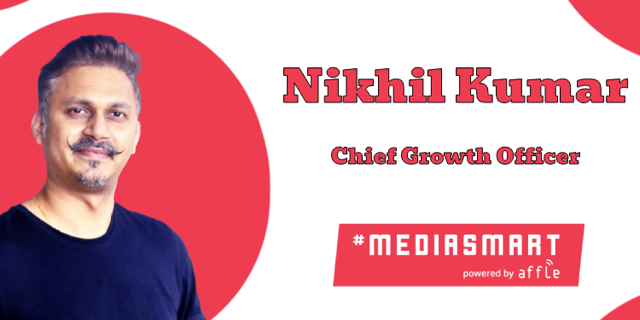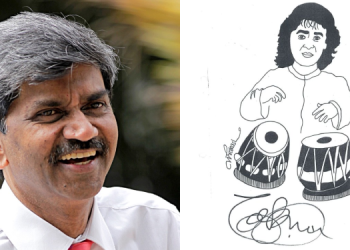Mediasmart, an Affle company is a unified programmatic platform that provides advertisers, trading desks, and agencies ways to integrate consumer journeys across screens. It recently did a strategic partnership with TCL, an Android TV manufacturer, to integrate their inventory with advertisers on Connected TV (CTV). By integrating TCL’s inventory with mediasmart’s programmatic ad solutions, the partnership aims to unlock ad opportunities for brands, while democratising the CTV space beyond the Walled Gardens.
Medianews4u.com caught up with Nikhil Kumar, Chief Growth Officer mediasmart:
He is a consumer marketing professional with over a decade of experience working in FMCG, Retail, F&B and Ad-Tech set-ups with global brands like Puma, L’Oreal, Cafe Coffee Day and recently Bytedance and InMobi. He was voted and awarded as one of India’s Most innovative Mar-Tech leaders in 2019 by the World Marketing Congress. With a career spanning over 14+ years – he has worked across multiple functions with his domain expertise primarily being Brand Marketing (digital and offline), Business strategy/ Sales and Go-To Market plan/ execution across consumer goods, retail and startup eco system.
Q. How did the deal between mediasmart and TCL come about? What other deals does mediasmart have with TV manufacturers?
The CTV space is fast expanding and as a leading CTV programmatic player, we are looking to create a larger ecosystem of partners on CTV – be it OEMs, OTTs, news, and FAST channels – that elevates the advertising landscape. From an opportunity standpoint, we’re partnering with all the leading partners across these verticals to be able to create value for advertisers.
The partnership between mediasmart and TCL, particularly, opens up exciting opportunities for advertisers to reach audiences through prime placements like the ‘Home Screen’ and get access to over 135 FAST channels. Through this partnership we also aim to co-create solutions through the ‘TV+’ offering, which allows specific content genre-based targeting like news, sports, entertainment, movies, etc, and empowers advertisers a more targeted way to reach those audiences transitioning from linear to FAST channels.
Q. While CTV is still in its early days in India, what growth potential does mediasmart see for advertisers?
India’s digital landscape is rapidly evolving, driven by increasing internet penetration, the proliferation of smart devices, and a young, tech-savvy population. This transformation has already set the stage for CTV to become a major player in the advertising ecosystem. CTV is here and it’s now! With over 46+ OTT apps and a growing FAST channel ecosystem, CTV exemplifies the broad appeal of these platforms across various user groups and demographics. As more consumers shift towards on-demand viewing, CTV is going to become a prominent feature in media mix for advertisers to tap into the highly engaged audiences.
With CTV advertising offering more precision targeting as compared to linear TV, greater measurability and immersive ad experiences, advertisers have an attractive proposition to maximize their ROI. There’s also the promise to do more with CTV and get measurable, outcome-driven results that go beyond the TV screens. With mediasmart’s proprietary Household Sync technology, we offer advertisers the ability to target multiple devices within the same household and re-target users within the same household. Brands can also sync their CTV campaigns across multi-screens such as DOOH and mobile, and also drive users to improve conversions in stores through footfall tracking. With power-packed technological prowess, CTV advertising unlocks new growth opportunities and effectively engages with India’s dynamic and diverse audience.
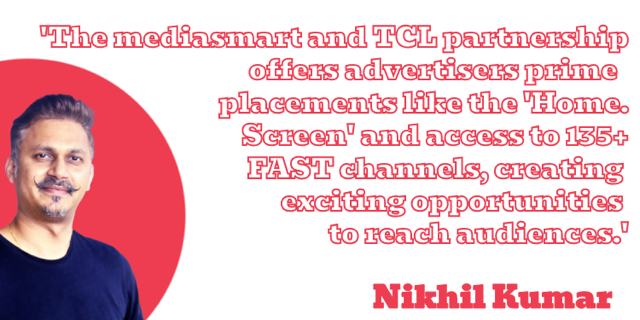
Q. With sports to a large extent being free on digital, including the Olympic Games, what boost will this give CTV advertising?
Major sporting events like the Olympics offer premium advertising slots, particularly during live broadcasts, highlights and key moments. Advertisers can capitalise on these high-visibility opportunities to showcase their brands to a captivated audience, driving higher ad recall and brand awareness. Additionally, it’s also worthy to note that the Olympic Games are not just consumed on OTTs – consumers of Olympics-related content also watch special events related to the Games on social media channels, lifestyle channels, as well as news.
Beyond CTV, consumer engagement is also increased on platforms such as mobiles and DOOH. CTV advertising can thus be an essential part of a multi-screen strategy. It’s about making sure that CTV advertising synchronises the right messaging across right platforms to reinforce brand presence and maximise campaign impact.
Q. CTV advertising allows for precision targeting. Is this its USP compared to traditional TV advertising?
Precision targetting is absolutely a key differentiator for CTV compared to traditional TV advertising. With CTV, advertisers can segment audiences based on detailed demographics, viewing habits, and interests, ensuring that ads are highly relevant to each viewer. This level of targetting has not been achievable with traditional TV, which relies on broad-based programming. Additionally, CTV provides real-time analytics and optimisation capabilities, allowing advertisers to adjust their campaigns on the fly for maximum effectiveness. This precision and flexibility make CTV a powerful tool for reaching and engaging target audiences.
Q. What role is GenAI playing in delivering more interactive ad formats?
GenAI is revolutionising every industry and the possibilities for advertising are exciting to witness! GenAI on CTV has the potential to generate highly relevant and engaging ads tailored to individual viewer preferences and behaviours. With GenAI, advertisers can create contextual and interactive ad formats tailored to specific audiences, households, and affinity groups based on their content viewing habits.
For eg, a sports apparel brand can target different audiences across the length and breadth of a diverse country like India with engaging vernacular creatives created in real-time and contextual to the location. Brand safety is another area where GenAI has the ability to make ad formats more relevant and engaging. With mediasmart’s AI CTVSafe feature, for instance, it is able to assess ad suitability of CTV traffic to automatically filter out risk categories. The result is a more immersive and engaging ad experience that drives higher levels of viewer interaction and conversion.
Q. How is AI helping brands use ad budgets in a far more efficient manner? Any examples?
AI is instrumental in helping brands optimise their ad budgets by enabling precise targeting, real-time optimisation, and detailed performance analysis. For example, AI algorithms can analyse vast amounts of data to identify the most effective audience segments and the best times to deliver ads, ensuring that ad spend is directed toward high-performing areas. This leads to reduced waste and higher ROI. These efficiencies are driven by AI’s ability to continuously learn and adapt to changing viewer behaviors.
Q. How is mediasmart using AI to improve its solutions?
At mediasmart – and at Affle – AI is the cornerstone of all our R&D efforts and innovations. Several of our solutions leverage AI-driven technologies to improve the future of advertising and enable long-term growth. AI-driven technologies on CTV improve targeting accuracy to serve ads that go beyond just demographic targeting, but also allow advertisers to target at the household level.
Our Household Sync, Engagement Sync, and App Sync solutions all have AI at the heart of the technology to optimise ad delivery and deliver measurable outcomes. Additionally, we use AI to optimise ad placements in real-time and the advanced analytics ensure that advertisers get real-time deep insights into campaign performance and viewer engagement.
Now with GenAI, Affle has also filed 15 new patents in India that cover futuristic applications in interaction, training, and integration of GenAI agents. The patents span advanced AI areas such as personalization, recommendation systems, predictive analysis, privacy, and enhanced fraud detection.
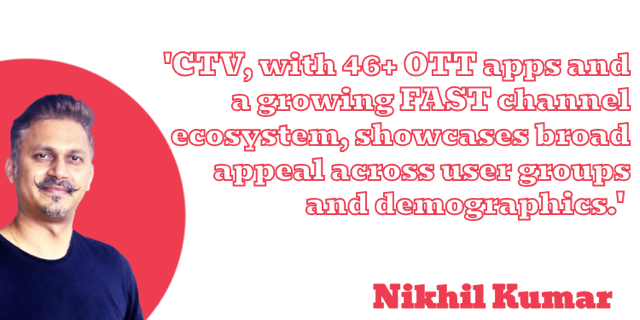
Q. What are the key ad categories and advertisers that use CTV a lot?
CTV advertising has been growing and finds affinity across industry verticals. Due to the wide demographic that uses CTV for content consumption, there’s scope for every kind of advertiser to find the users they are looking for. Key ad categories that heavily utilise CTV include consumer electronics, automotive, retail, and FMCG. Brands in the consumer electronics and automotive industries, for instance, use CTV to showcase their latest products with immersive ad formats that highlight key features and benefits. Retailers leverage CTV for personalised promotions and offers, and also to drive users to store for offline purchases.
The rich engagement capabilities of CTV, coupled with its ability to deliver targeted messages to a diverse audience base, make it a compelling choice for advertisers across industries. By harnessing the power of CTV, brands can effectively enhance their marketing efforts, connect with consumers through an omnichannel approach, and achieve measurable results in the competitive advertising landscape.
Q. Apart from sports, are news and lifestyle the other genres that will benefit from CTV advertising?
CTV’s appeal goes beyond sports viewing on OTT. News and lifestyle channels are popular content categories consumed on CTVs and on FAST channels. Viewers of news content are often highly engaged and seek timely, relevant information, making them an attractive audience for advertisers. Lifestyle content, including cooking shows, travel, and wellness, also attracts a dedicated following that is ideal for targetted advertising.
These genres offer ample opportunities for brands to connect with viewers in meaningful ways, using CTV’s interactive and immersive ad formats. The ability to deliver personalised and contextually relevant ads enhances the viewing experience and drives higher engagement and conversion rates.
Q. How does mediasmart’s Household Sync technology enable brands to target better?
mediasmart’s proprietary Household Sync technology is a game-changer for brands on CTV to deliver coordinated ad campaigns across multiple devices within a single household. By recognising and targeting all connected devices used by household members, we ensure that the ad message is consistently delivered across screens. This technology enables brands to create a seamless and cohesive ad experience, reinforcing the message and improving recall.
It also allows for more precise targetting, as we can tailor ads based on the collective viewing habits and preferences of the household. This holistic approach enhances the overall impact of the advertising campaign and drives better engagement and results.
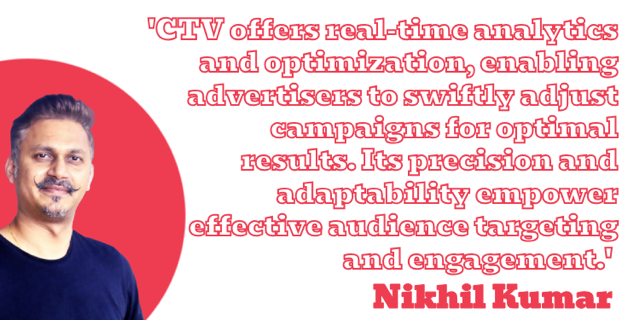
Q. What trends are we seeing in the consumption of FAST channels in the country?
The consumption of FAST channels is on the rise, driven by the growing demand for diverse and flexible content options. Viewers of FAST are also driven to these channels as they transition from linear TV but are not yet paying subscribers of SVOD platforms. With free content available on FAST channels, viewers are able to enjoy the immersive on-demand experience and get access to niche programming and live events. Advertisers are taking note of this shift and are leveraging FAST channels to reach a broader audience with targeted and engaging ads. We expect this trend to continue as more viewers discover the benefits of FAST channels.
Q. Could you shed light on the brand lift studies that mediasmart has done with Kantar for clients? What have the results shown?
Our brand lift studies with Kantar have provided valuable insights into the effectiveness of CTV advertising. These studies measure key metrics such as brand awareness, purchase intent, message association, and brand favorability. The results have consistently shown significant improvements across these metrics, demonstrating the strong impact of CTV advertising on brand perception and consumer behaviour.
Q. How is digital giving OOH a boost in the country compared to static hoardings? What are mediasmart’s plans when it comes to CTV?
Digital Out-Of-Home (DOOH) advertising is transforming the traditional static hoarding landscape by offering dynamic and interactive ad experiences. Digital screens can display a variety of content formats, including videos, animations, and real-time updates, making ads more engaging and impactful. Additionally, DOOH allows for precise targeting based on location and audience demographics, enhancing the relevance of the ads.
At mediasmart, we are committed to integrating CTV with DOOH and mobile screens to create a cohesive advertising ecosystem. Our multi-screen focus leverages advanced targeting and measurement capabilities to deliver seamless ad experiences across CTV , DOOH and mobile , maximising reach and engagement for our clients.

